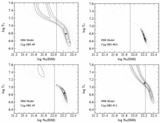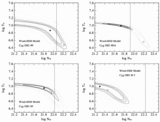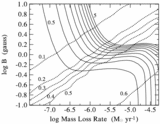Image Details

Caption: Fig. 8.
Model prediction of the expected changes in the (a) normalized X‐ray and radio fluxes and (b) the radio spectral indices for a wind structure subjected to a propagating density disturbance. This shows that a significant time delay between X‐ray and radio variability is expected and the strengths of the two variable emissions should be comparable. The X‐ray behavior demonstrates that as the disturbance enters the X‐ray generation region, the X‐ray emission increases, and as the disturbance passes this region, the X‐ray absorption increases, producing a decrease in X‐ray emission. The increase in radio emission is more pronounced at lower wavelengths, i.e., a propagating density disturbance cannot produce comparable radio fluctuations at all radio wavelengths. This mechanism can produce radio spectral indices greater than 0.6 but cannot produce indices significantly lower than 0.6.
Copyright and Terms & Conditions
©1998. The American Astronomical Society. All rights reserved. Printed in U.S.A.











